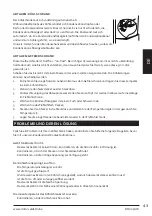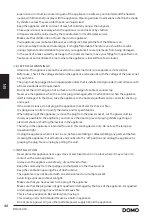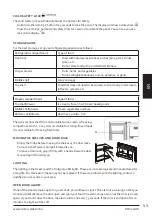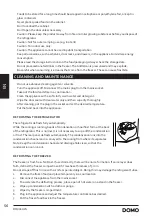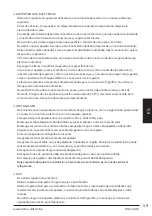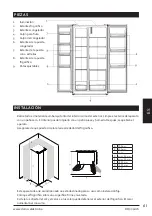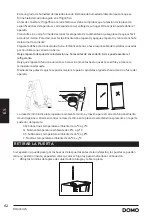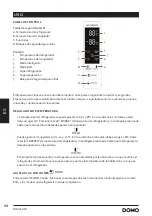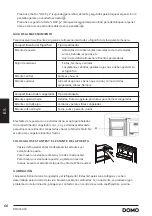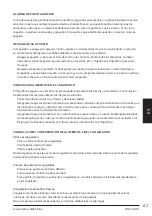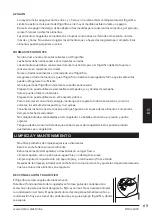
56
DO99503S
EN
· Foods to be stored for a long time should be wrapped in cellophane or polyethylene foil, or kept in
glass containers.
· Never place spoiled foods in the cabinet.
· Don’t overload the cabinet.
· Don’t open the door unless necessary.
· Caution: Please keep the products away from fire or similar glowing substances before you dispose of
the refrigerator.
· Caution: Not for outer camping use (e.g. in a tent).
· Caution: For indoor use only.
· Caution: The appliance cannot be used in public transportation.
· Keep all accessories, such as shelves, door racks, and drawers, in the appliance to minimise energy
consumption.
· Please read the storage instructions on the food packaging. Always check the storage date.
· Do not place carbonated drinks in the freezer. The bottle/can is pressurised and may explode.
· Be careful when consuming ice creams that come from the freezer. These can cause frostbite.
CLEANING AND MAINTENANCE
· Do not use abrasive cleaning agents or solvents.
· Turn the appliance off. Disconnect the mains plug from the mains socket.
· Take out the food and store in a cool location.
· Clean the appliance with a soft cloth, warm water and detergent.
· Wipe the door seal with clear water only and then wipe dry thoroughly.
· After cleaning, put the plug in the socket and set the desired temperature.
· Put the food back into the appliance.
DEFROSTING THE REFRIGERATOR
The refrigerator defrosts fully automatically.
While the cooling is running, beads of condensation or hoarfrost form at the back
of the refrigerator. This is normal. It is not necessary to wipe off the condensation
or frost. The rear panel defrosts automatically. The condensation runs into the
condensation channel and is conveyed to the cooling from where it evaporates.
Note: Keep the condensation channel and drainage hole clean, so that the
condensation can run out.
DEFROSTING THE FREEZER
The freezer is frost-free – NoFrost. If used correctly, there will be no ice formation. If an ice layer does
form, defrost the freezer compartment if it reaches a thickness of 3 mm.
Do not scrape off frost or ice with a knife or pointed object. Doing this may damage the refrigerant tubes.
1.
Remove the frozen food and place temporarily in a cool location.
2.
Disconnect the appliance from the mains socket.
3.
To accelerate the defrosting process, place a pan of hot water on a stand in the freezer.
4.
Wipe up condensation with a cloth or sponge.
5.
Wipe dry the freezer compartment.
6.
Plug in the appliance and adjust the temperature control knob as desired.
7.
Put the frozen food back in the freezer.


